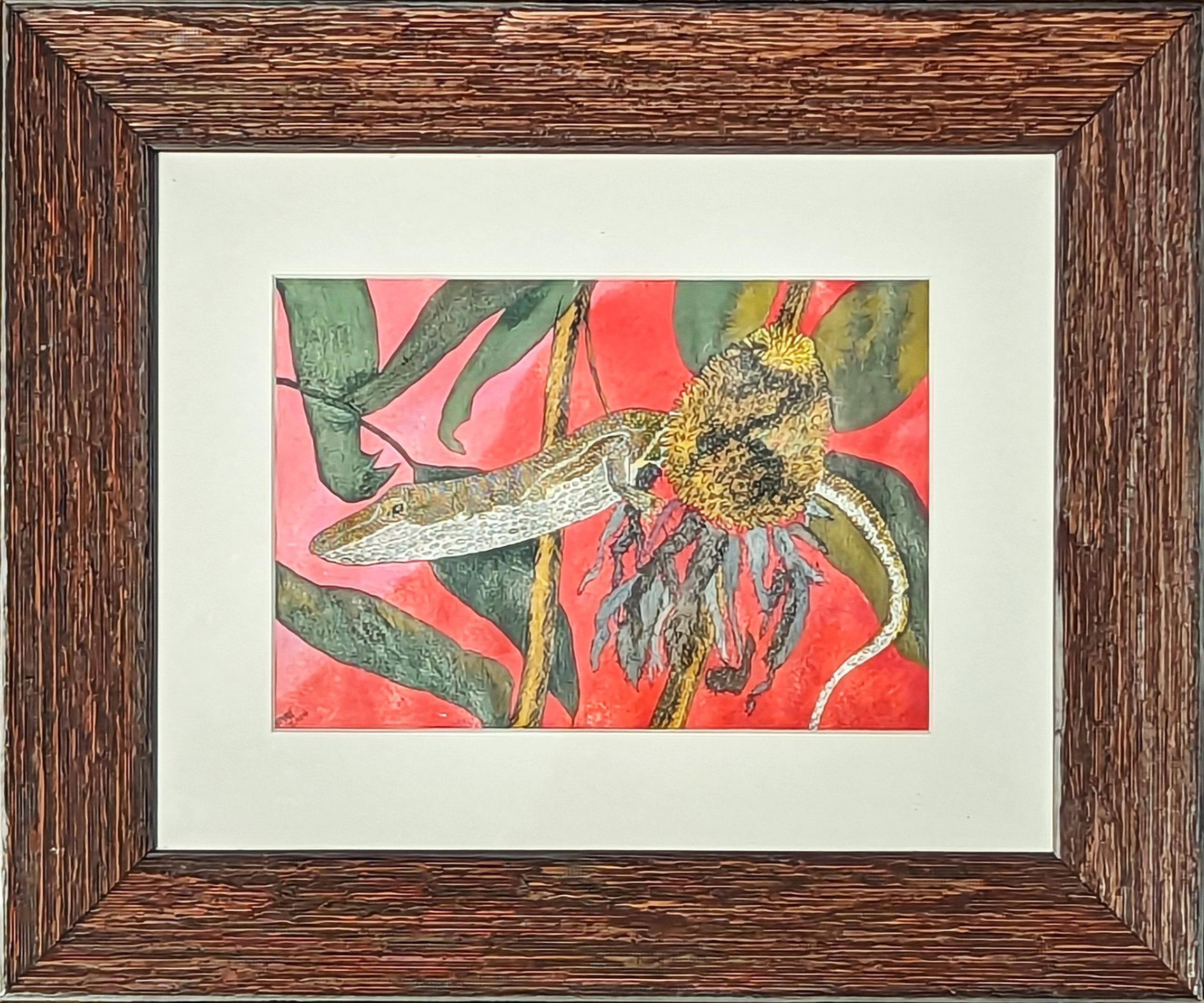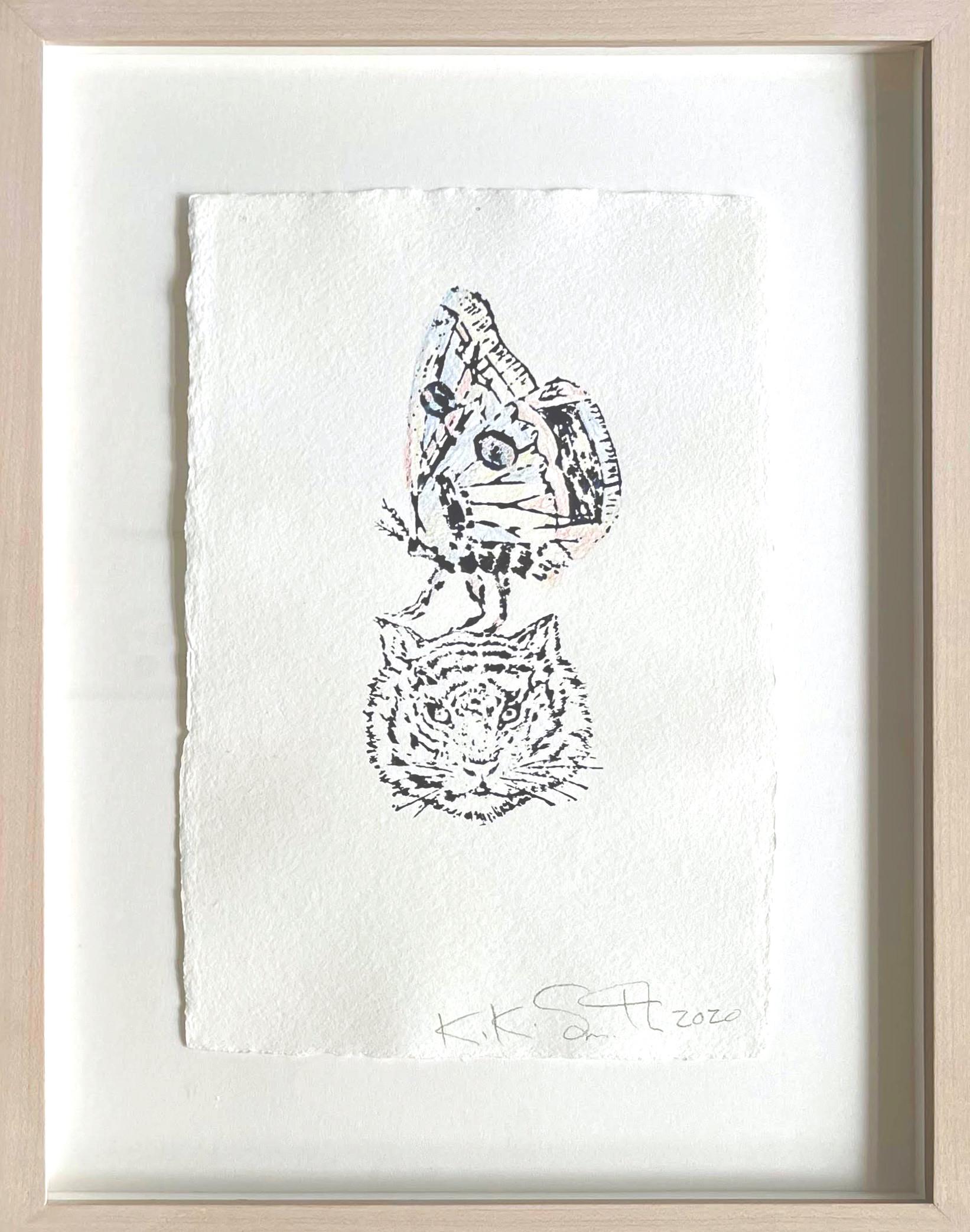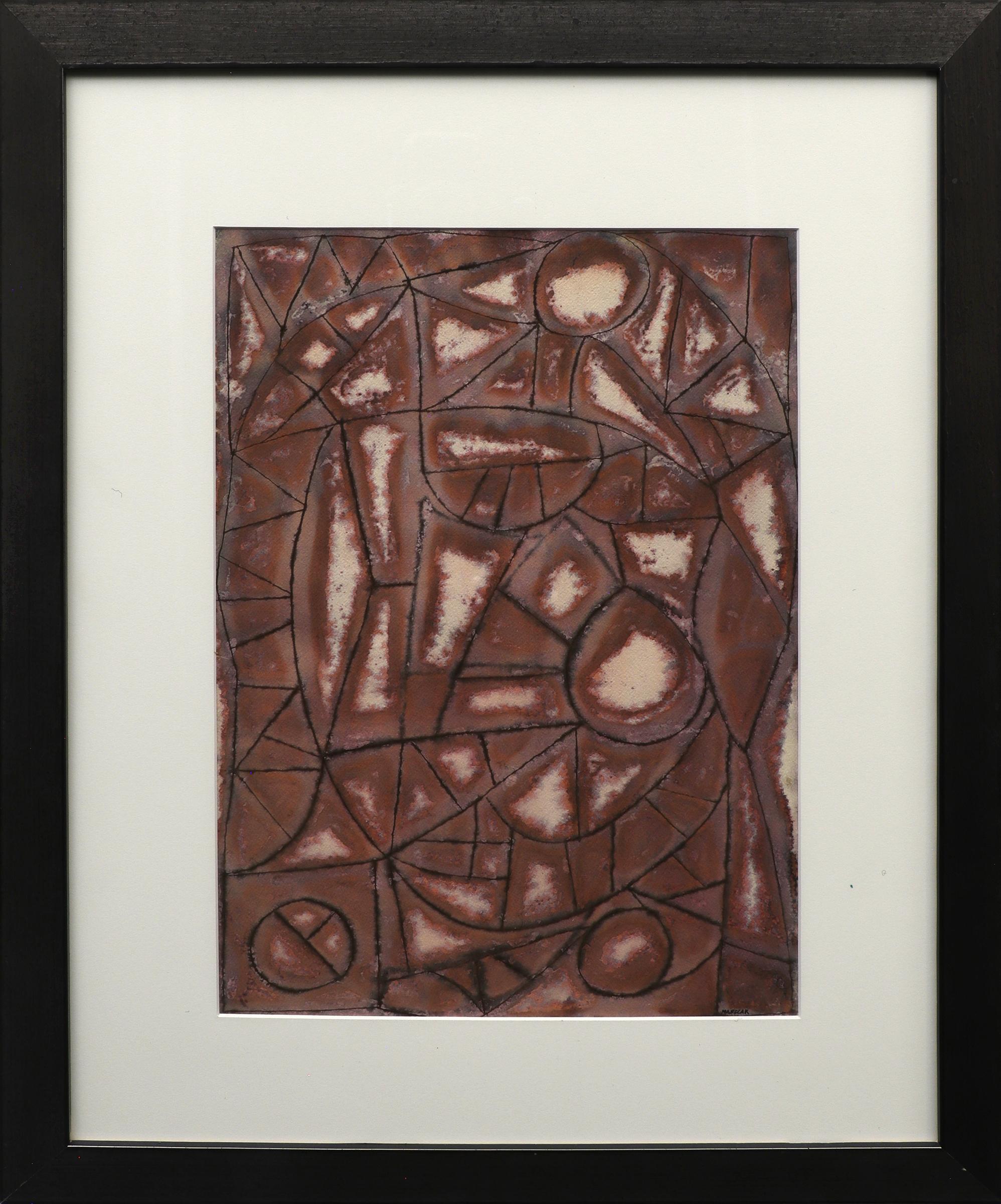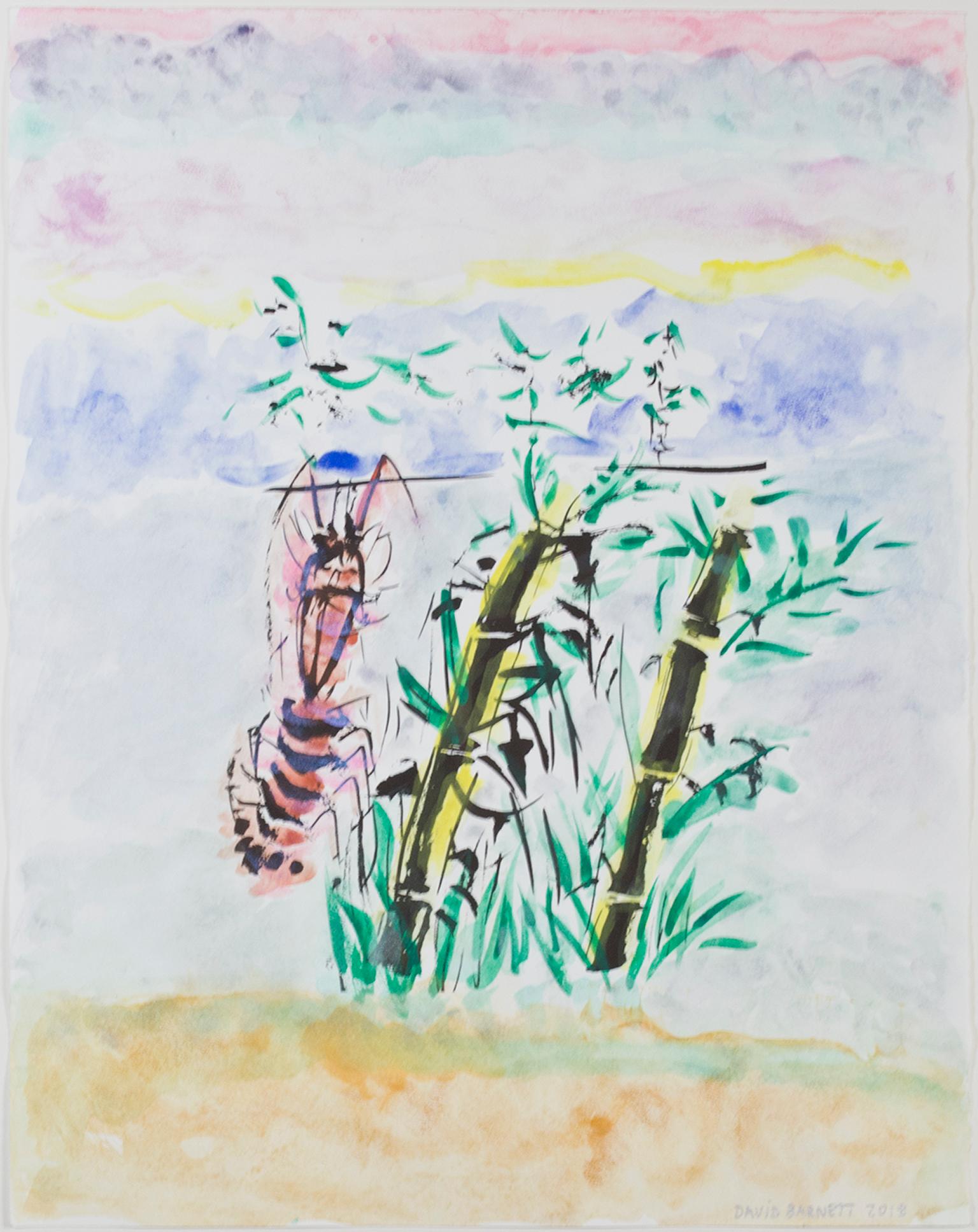Items Similar to An original British 20th Century drawing by British illustrator Heath Robinson
Want more images or videos?
Request additional images or videos from the seller
William Heath RobinsonAn original British 20th Century drawing by British illustrator Heath Robinson1921
1921
About the Item
William Heath Robinson (British, 1872-1944)
'The Friendly Dog'
Signed 'W. Heath Robinson.' (lower right)
Pen and ink on paper
11 X 8.1/2in. (28 X 21.7cm.) (excluding frame)
46 x 38cm. (18.1/4 x 15in. (including frame)
Literature: 'Old Time Stories', Constable and Co. 1921, P. 143
William Heath Robinson was an artist and illustrator mainly associated with his gloriously complicated inventions for simple objectives. The name Heath Robinson has become commonplace in the English language as a result to describe anything mechanical that is eccentric, ridiculously complex and ingenious at the same time .
Interestingly one of the automatic analysis machines built for Bletchley Park during the Second World War to assist in the decryption of German message traffic was named "Heath Robinson" in his honour. It was a direct predecessor to the Colossus, the world's first programmable digital electronic computer
The Heath Robinson museum has recently been opened in Pinner, North London, aided partly by Lottery funding and houses similar works to these examples.
- Creator:William Heath Robinson (1872 - 1944, British)
- Creation Year:1921
- Dimensions:Height: 11.03 in (28 cm)Width: 8.55 in (21.7 cm)Depth: 0.4 in (1 cm)
- Medium:
- Period:
- Condition:Good condition, small dirt spots upper middle right. Slight creases on close inspection, otherwise in good condition. In a simple gilded frame behind glass in a double mount, the outer mount light grey.
- Gallery Location:Petworth, GB
- Reference Number:1stDibs: LU54031640163
About the Seller
4.9
Platinum Seller
These expertly vetted sellers are 1stDibs' most experienced sellers and are rated highest by our customers.
Established in 2010
1stDibs seller since 2017
228 sales on 1stDibs
Typical response time: 3 hours
- ShippingRetrieving quote...Ships From: Petworth, United Kingdom
- Return PolicyA return for this item may be initiated within 10 days of delivery.
More From This SellerView All
- Mid Century, modern British artist Sven Berlin, a strutting cockerelLocated in Petworth, West SussexSven Berlin (British, 1911 - 1999) A strutting cockerell Pen and ink 8 x 4.5/8 in. (20 x 12 cm.) (4) Sven Berlin, born in Sydenham, London on 14th Septemb...Category
20th Century Modern Animal Drawings and Watercolors
MaterialsPaper, Ink, Pen
- Cornish, St. Ives artist Sven Berlin drawing 'White bird', pen and ink on paperLocated in Petworth, West SussexSven Berlin (British, 1911 - 1999) White bird Pen and ink Signed with monogram, inscribed and dated `WHITE BIRD SclPT MY 87 SB’ (lower middle) 12.3/4 x 7.3/4 in. (32.3 x 19.7 cm.) S...Category
20th Century Modern Animal Drawings and Watercolors
MaterialsPaper, Ink, Pen
- Modern British, 20th Century St. Ives artist, Sven Berlin, 'Equus' drawingLocated in Petworth, West SussexSven Berlin (British, 1911 - 1999) Equus Pen and ink 7.7/8 x 12.3/4 in. (19.7 x 32.4 cm.) Sven Berlin, born in Sydenham, London on 14th September 1911, was an English painter, draug...Category
20th Century Romantic Animal Drawings and Watercolors
MaterialsInk, Pen, Paper
- Early 20th Century British illustration of a hornbill bird by Edward DetmoldBy Edward Julius DetmoldLocated in Petworth, West SussexEdward Julius Detmold (British, 1883 – 1957) Hornbill Pen and ink on paper Signed with initials’ ED’ (lower right) 16.3 x 15.8 cm. Edward Julius Detmold (21 November 1883 Putney, Wandsworth, Surrey - 1 July 1957 Montgomery) and his twin brother Charles Maurice Detmold (1883-1908) were prolific Victorian book illustrators. Their parents were Edward Detmold and Mary Agnes Luck. Their father, an electrical engineer was chronically ill, and they lived with their uncle and guardian, Dr Edward Barton Shuldham, who saw to their tuition and was a noted collector of porcelain and Japanese woodprints of plants and animals. Dr Shuldham occupied a house in Upper Richmond Road, Putney, where the twins had been born. He ensured their interest in natural history and art, and created a nurturing environment for their precocious talents. They also spent time with another uncle, the painter Henry E. Detmold, who encouraged them in their art. Most of their prodigious energy was expended on depicting animal subjects and their work showed great influence from traditional Japanese art, Albrecht Dürer and later the Art Nouveau movement. They were exhibiting watercolours at the Royal Academy and the Royal Institute of Painters in Water Colours at the age of 13. Edward Burne-Jones praised their work and warned against the dangers of uniformity inherent in art schools. The twins subsequently mastered the techniques of watercolour etching and of colour printing with copper plates, buying a printing press and producing their own proofs at home. In 1898 they compiled a portfolio of colour etchings of animals and flowering plants done in the Japanese style. These were much sought after and were rapidly sold out. They collaborated on the etchings and illustrations for their first book Pictures From Birdland published in 1899. This book resulted from a number of drawings being shown in the autumn of 1897, to the publisher J. M. Dent, who was so impressed that the two brothers were asked to provide coloured illustrations for a book of his. The first title mooted was Alphabet of Birds, eventually becoming Pictures from Birdland. "Particularly noticeable are the early influences in the paintings, Edward's design for an osprey, with its unusual water effects, testifying to a Japanese contribution. Already apparent is that style in which a searching study of natural forms, especially bird plumage, is subordinated to decorative arrangement" - David Larkin (The Fantastic Creatures of Edward Julius Detmold) This was followed in 1900, by an exhibition at the Fine Art Society's Gallery in London. Their next joint project was to produce a set of 16 watercolours for Rudyard Kipling's The Jungle Book published in 1903, by Macmillan. The success of their painting careers seemed assured, but Maurice ended his life by inhaling chloroform in April 1908, shortly before they were due to leave for a holiday in Sussex with Dr Shuldham, who had arranged that Maurice put down the household cats using the anaesthetic. Although stunned by the death of Maurice, Edward threw himself into his work. The recognition accorded the twins' illustrations of Kipling's classic tale was extraordinary. Consequently, in 1909 Edward illustrated The Fables of Aesop, producing 23 colour plates and a host of pen & ink drawings. This proved so popular that in 2006 The Folio Society of London published a facsimile of the original Hodder & Stoughton edition. In 1911, Detmold worked on illustrations for Maurice Maeterlinck's The Life of the Bee, Camille Lemonnier's Birds and Beasts and Florence Dugdale's Book of Baby Beasts. In the following year he worked on Maeterlinck's Hours of Gladness, in 1913, on Florence Dugdale's Book of Baby Birds and in 1919, on W. H. Hudson's Birds in Town and Village In 1919, he also produced a portfolio of Twenty Four Nature Pictures and, in 1921, on Our Little Neighbours and Jean-Henri...Category
20th Century Art Deco Animal Drawings and Watercolors
MaterialsInk, Pen, Paper
- British illustration by EH Shephard, illustrator for Winnie the PoohLocated in Petworth, West SussexErnest Howard Shephard (British, 1879 – 1976) The land of the lost toys – ‘Oh that’s you is it’ Inscribed with title (lower edge), and further inscribed ...Category
20th Century English School Animal Drawings and Watercolors
MaterialsInk, Paper, Pen
- Sven Berlin, Cornish St. Ives artist, 20th Century 'Pegasus' drawingLocated in Petworth, West SussexSven Berlin (British, 1911 - 1999) Pegasus Pen and ink on paper laid down on card 11 x 7.7/8 in. (28 x 20 cm.) (16) Sven Berlin, born in Sydenham, London ...Category
20th Century Modern Animal Drawings and Watercolors
MaterialsInk, Pen
You May Also Like
- “Anatole in the Red City” Red & Green Abstract Drawing of a Reptile by a PlantLocated in Houston, TXRed and green abstract drawing by Houston, TX artist Marguerite Baldwin. The drawing depicts a lizard on a plant against a red background. Signed and dated by the artist at the bottom left corner. The piece is framed and matted in a natural raised wood grain frame. Dimensions Without Frame: H 7 in. x W 10 in. Artist Biography: "I waited until I was 61 to get a BFA in photography at Sam Houston...Category
2010s Abstract Animal Drawings and Watercolors
MaterialsInk, Pen, Permanent Marker
- Tiger MothBy Kiki SmithLocated in New York, NYKiki Smith Tiger Moth, 2020 Ink and colored pencil on Twin Rocker hand made paper with deckled edges Pencil signed and dated by Kiki Smith on the front Frame Included; elegantly floa...Category
2010s Contemporary Animal Drawings and Watercolors
MaterialsHandmade Paper, Ink, Color Pencil
- SWAN IN LOVE (TEOREMA 50)By Christina McPheeLocated in New York, NYSWAN IN LOVE (TEOREMA 50), 2012 ink, watercolor, airbrush paint, graphite on paper 37.5 x 52 inches / 952 x 1320 mm unframed Christina McPhee’s expansive abstract paintings, drawings, photographs, and videos test or query how can we know, and who is we? Moving from within a matrix of measurement, observation and contingent effects, her work resists characterization as product, and continually accesses fields outside itself. For her, process equals trial. Her work emulates potential forms of life, in various systems and territories, from a perspective of the non-self– a world beyond identity. McPhee’s dynamic, performative, physical engagement with materials, in both her analogue and digital works, is a seduction into surface-skidding calligraphic gestures and mark-making. The tactics of living are in subterfuge, like the ‘dazzle ships...Category
21st Century and Contemporary Contemporary Abstract Drawings and Waterco...
MaterialsArchival Ink, Archival Paper
- The Chicken, 1940s Abstract Geometric Pen Ink Drawing, Red, Black, CreamBy Edward MarecakLocated in Denver, CO"The Chicken", is ink on paper by Denver artist Edward Marecak (1919-1993) from the 1940's of an abstract depiction of a chicken in black and red. Presented in a custom black frame, outer dimensions measure 23 ¾ x 19 ¾ inches. Image size measures 15 ¾ x 11 ½ inches. Drawing is clean and in very good condition - please contact us for a detailed condition report. Provenance: Estate of the Artist, Edward Marecak Expedited and international shipping is available - please contact us for a quote. About the Artist: Born to immigrant parents from the Carpathian region in Slovakia, Marecak grew up with his family in the farming community of Bennett’s Corners, now part of the town of Brunswick, near Cleveland, Ohio. When he turned twelve, his family moved to a multi-ethnic neighborhood of Poles, Czechs, Slovaks and Slovenians in Cleveland. His childhood household cherished the customs and Slavic folk tales from the Old Country that later strongly influenced his work as a professional artist. During junior high he painted scenery for puppet shows of "Peter and the Wolf," awakening his interest in art. In his senior year in high school he did Cézanne-inspired watercolors of Ohio barns at seventy-five cents apiece for the National Youth Administration. They earned him a full scholarship to the Cleveland Institute of Art (1938-1942) where he studied with Henry George Keller whose work was included in the 1913 New York Armory Show. In 1940 Marecak also taught at the Museum School of the Cleveland Institute. Before being drafted into the military in 1942, he briefly attended the Cranbrook Academy of Art near Detroit, one of the nation’s leading graduate schools of art, architecture, and design. A center of innovative work in architecture, art and design with an educational approach built on a mentorship model, it has been home to some of the world’s most renowned designers and artists, including Eero Saarinen, Charles Eames, Daniel Libeskind and Harry Bertoia. Marecak’s studies at Cranbrook with painter Zoltan Sepeshy and sculptor Carl Milles were interrupted by U.S. army service in the Aleutian Islands during World War II. Following his military discharge, Marecak studied on the G.I. Bill at the Colorado Springs Fine Arts Center from 1946 to 1950, having previously met its director, Boardman Robinson, conducting a seminar in mural painting at the Cleveland Institute of Art. Although he did not work with Robinson at the Fine Arts Center, who had become quite ill - retiring in 1947 - he studied Robinson’s specialty of mural painting before leaving to briefly attend the Cranbrook Academy in 1947. That same year he returned to the Fine Arts Center, studying painting with Jean Charlot and Mary Chenoweth, and lithography with Lawrence Barrett with whom he produced some 132 images during 1948-49. At the Fine Arts Center he met his future wife, Donna Fortin, whom he married in 1947. Also a Midwesterner, she had taken night art courses at Hull House in Chicago, later studying at the Art Institute of Chicago with the encouragement of artist Edgar Britton. After World War II she studied with him from 1946 to 1949 at the Fine Arts Center. (He had moved to Colorado Springs to treat his tuberculosis.) Ed Marecak also became good friends with Britton, later collaborating with him on the design of large stained glass windows for a local church. In 1950-51 Marecak returned to the Cleveland Institute of Art to complete his Bachelor of Fine Arts degree. A year later he was invited to conduct a summer class at the University of Colorado in Boulder, confirming his interest in the teaching profession. In 1955 he received his teaching certificate from the University of Denver. Vance Kirkland, the head of its art department, helped him get a teaching job with the Denver Public Schools so that he and his family could remain in the Mile High City. For the next twenty-five years he taught art at Skinner, Grove, East, George Washington and Morey Junior High Schools. Prior to coming to Colorado, Marecak did watercolors resembling those of Winslow Homer, John Singer Sargent and Charles Burchfield. However, once in Colorado Springs he decided to destroy much of his earlier ouevre, embarking on a totally new direction unlike anything he had previously done. Initially, in the 1940s he was influenced by surrealist imagery and Paul Klee, and in the West by Indian petroglyphs and Kachinas. His first one-person show at the Garrett Gallery in Colorado Springs in 1949 featured paintings and lithographs rendered in the style of Magic Realism and referential abstraction. The pieces, including an oil Witch with Pink Dish, foreshadowed the output of his entire Colorado-based career, distinguished by a dramatic use of color, intricacy of execution and attention to detail contributing to their visual impact. He once observed, "Each time I start a new painting I always fool myself by saying this time keep it simple and not get entangled with such complex patterns, color and design; but I always find myself getting more involved with richness, color and subject matter." An idiosyncratic artist proficient in oil, acrylic, watercolor, gouache and casein, he did not draw upon Colorado subject matter for his work, unlike many of his fellow painters in the state. Instead he used Midwest landscape imagery, bringing to life in it witches and spirits adapted from the Slovakian folk tales he heard growing up in Ohio. A number of his paintings depict winter witches derived from the Slovak custom in the Tatra Mountains of burning an effigy of the winter witch in the early spring to banish the memory of a hard winter. The folk tale element imparts a dream-like quality to many of his paintings. A devote of Greek mythology, he placed the figures of Circe, Persephone, Sybil, Hera and others in modern settings. The goddess in Persephone Brings a Pumpkin to her Mother, attired as a Midwestern farmer’s daughter, heralds the advent of fall with the pumpkin before departing to spend the winter season in the underworld. Train to Olympus, the meeting place of the gods in ancient Greece, juxtaposes ancient mythology with modernity creating a combination of whimsy and thought-provoking consideration for the viewer. Voyage to Troy #1 alludes to the ancient city that was the site of the Trojan Wars, but has a contemporary, autobiographical component referencing the harbor of the Aleutian Islands recaptured from the Japanese during World War II. In the 1980s Marecak used the goddess Hera in his painting, Hera Contemplates Aspects of the Art Nouveau, to comment on art movements in the latter half of the twentieth century Marecak’s love of classical music and opera, which he shared with his wife and to which he often listened while painting in his Denver basement studio, is reflected in Homage of Offenbach, an abstract work translating the composer’s musical colors into colorful palette. Pace, Pace, Mio Dio, the title of his earliest surrealist painting, is a soprano aria from Verdi’s opera, La Forza del Destino (The Force of Destiny or Fate, a favorite Marecak subject). His Queen of the Night relates to a character from Mozart’s opera, The Magic Flute. In addition to paintings and works on paper, he produced hooked rugs, textiles and ceramics. He likewise produced designs for ceramics, tableware and furniture created by his wife Donna, an accomplished Colorado ceramist. Both of them generally eschewed exhibitions and galleries, preferring to quietly do their work while remaining outside of the mainstream. He initially exhibited at the Colorado Springs Fine Arts Center in 1948 receiving a purchase award. The following year he had his first one-person show of paintings and lithographs at the Garrett Gallery in Colorado Springs. In the 1950s and early 1960s he participated in group exhibitions at the Print Club (Philadelphia); Amarillo Public Library (Texas); annual Blossom Festival Show (Canon City, Colorado); Adele Simpson’s "Art of Living" in New York; Denver Art Museum; and the Fox Rubenstein-Serkey Gallery (Denver); but he did not have another one-person show until 1966 at the Denver home of his friends, John and Gerda Scott. They arranged for his first one-person show outside of Colorado held two years later at the Martin Lowitz Gallery in Beverly Hills and Palm Springs, California. That same year his work was featured at the Zantman Galleries in Carmel, California. Thereafter he became an infrequent exhibitor after the 1970s so that his work was rarely seen outside his basement studio. In 1980 he, his wife and Mark Zamantakis exhibited at Denver’s Jewish Community Center, and four years later he had a one-person show at the Studio Gallery in Denver. In 1992 he was included in a group show at the Rule Modern and Contemporary Gallery in Denver, and a year later received a large, posthumous retrospective at the Emmanuel...Category
1940s Abstract Geometric Abstract Drawings and Watercolors
MaterialsPaper, Ink
- "Bamboo & Lobster, " Original Surreal Ink & Watercolor signed by David BarnettBy David BarnettLocated in Milwaukee, WI"Bamboo & Lobster" is a reworking of a work from fifty-two years prior, "Bamboo, Lobster, & Cherries." It is an an original surrealist ink and watercolor drawing by David Barnett, si...Category
2010s Contemporary Abstract Drawings and Watercolors
MaterialsInk, Watercolor, Rag Paper
- "Whale in a Sea of Symbols, " Drawing on Handmade Paper by Miguel Castro LeñeroBy Miguel Castro LeñeroLocated in Milwaukee, WI"Whale in a Sea of Symbols" is an original ink and charcoal on handmade amate paper by Miguel Castro Leñero. The artist initialed the piece lower right. This piece features an abstra...Category
1990s Contemporary Animal Drawings and Watercolors
MaterialsCharcoal, Ink, Handmade Paper
Recently Viewed
View AllMore Ways To Browse
Illustrator Art
British 20th Century
North London
20th Century British Art
British 20th Century Artists
Britain War
W Britain
Artist Robinson
Early 20th Century British Paintings
Early 20th Century British Artists
Early 20th Century Illustrators
20th Century Art On Paper British
Antique Dog Sign
Old Pen
Pen Germany
British Dog
Automatic Drawing
Antique Pen Ink Drawings





